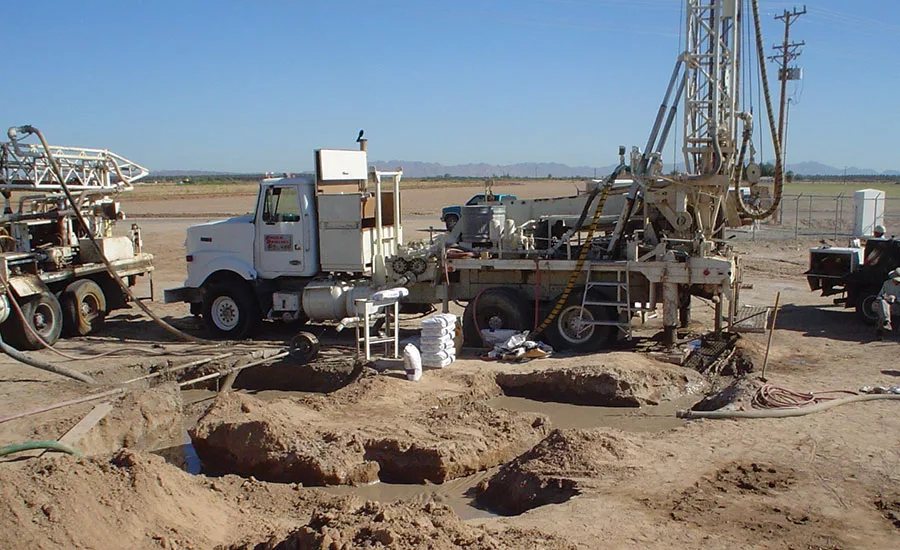High Solids Grouting Takes on New Meaning

Columnist Bob Oliver says it’s crucial to tailor your grout mix to site conditions. Source: CETCO Drilling Products
When pumpable, one-step, high-solids grouts hit the market in the late 1980s, solids content ranged from 20 percent to 30 percent. There were two-step pumpable grouts already in the market at that time and these were less than 20 percent solids.
The belief in the industry at that time was that the solids content of these one-step bentonite grouts had to contain only active solids, solids that would swell when hydrated. Bentonite industry researchers attempted every possibility they could find to raise the active solids content above 30 percent. They did not have much success.
Bentonite grouts that were 20 percent solids were mixed using 50 pounds of bentonite grout along with 24 gallons of water at a yield of 3.5 cubic feet per batch. The 30 percent solids grouts were mixed using 50 pounds of bentonite grout and 14 gallons of water for a yield of 2.2 cubic feet. These products were both quickly accepted for use in water wells, environmental monitoring wells and other grouting applications.
Bentonite producers had done some on-site testing, especially in dry areas, and found that there was some shrinking and cracking of the grout columns in the vadose zone, but it was believed that if the grout column did have some desiccation that it would quickly rehydrate when it came in contact with water again. The excitement over these grouts and their ease of use, plus the thought that they would rehydrate, overshadowed any doubts about the desiccation problem.
After a number of years of studying bentonite grouting products, most of which came in the form of the Nebraska Grout Task Force Study, we have learned much about grouting. These findings have clearly improved grouting and the protection of our groundwater.
We learned that:
- The highest solids possible yields the best grout. Bentonite chips or bentonite tablets are examples of highest-solids grout.
- Pumpable bentonite slurries do desiccate in the vadose zone and do not rehydrate when they come in contact with water.
- When pumpable slurries are used, the solids content does not have to be all active solids. It can be bentonite and silica sand, or bentonite and cement.
- The inactive solids, along with 20 percent or 30 percent solids bentonite grout, reduce the amount of desiccation to the grout column in the vadose zone.
- Bentonite grout columns that are below the water table will remain hydrated and do not shrink and crack, even at 20 percent to 30 percent solids.
- Cement grouts crack and shrink from PVC casing both above and below the water table.
These findings leave us with a variety of grouting options that will protect the groundwater in wells and other boreholes. It is now believed that bentonite chips or bentonite tablets will provide the best grout seal both above and below the water table. The solids content of these products normally exceeds 70 percent. Desiccation in the vadose zone will be minimized with these products. Bentonite chips are cheaper to use and are an effective seal, but are not as pure as tablets, do not fall through water as fast as tablets, do not hydrate as fast as tablets, and exhibit somewhat less structural strength compared to tablets. Bentonite chips are much more widely used than bentonite tablets, and are even used in environmental monitoring wells. However, there are times in certain applications where grouting is more critical and may require the use of tablets instead.
High-solids bentonite slurry grouts have different recommendations since these studies have been completed. The addition of fine silica sand is being recommended more often now in these slurries, especially in the dry conditions of the vadose zone. These additions of fine silica sand give marked improvement to the grout column and are not that difficult to pump. The sand does not affect the permeability of the grout column at lower concentrations, such as 4-to-1 ratios of sand to bentonite. At 8-to-1 ratios, only minimal effect has been observed. There are some areas that do not allow the use of these types of grouts unless they have additions of sand or cement.
Cement has also been added to bentonite grout to raise the solids content and improve setup of the grout column. This formula also reduces desiccation of the grout column. A formula of one 50-pound bag of grout along with one 94-pound bag of cement and 24 gallons of water has been approved for grouting in the state of Idaho.
There are some applications where bentonite grout cannot be used at all, such as in saline conditions. In cases like these, cement is the alternative. There have also been studies exploring various additives to cement to reduce shrinking and cracking. Some of these have shown success in reduction of shrinking and cracking in the grout column.
There are better grouting options than ever before in our industry. It is important to use the best one available for the application. There is no grout that works well in every application. There are a number of educational opportunities available to contractors to learn about grouting in various applications. If you have questions about the above information, please contact me through National Driller. You can also contact your bentonite manufacturer or local distributor regarding these products.
Looking for a reprint of this article?
From high-res PDFs to custom plaques, order your copy today!

